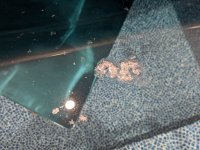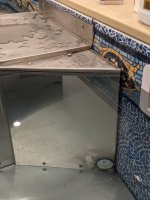So, this is what I did: In order to minimize harm to my pool walls (behind vinyl liner) and all the stainless steel submerged in my pool water (endless pool), and all the other equipment hooked up to the bonding wire, I installed a zinc anode to the same stainless steel plate that the pool water bonding wire attaches to. See attached picture. At the bottom you will see an actively corroding zinc anode which I purchased from a marine supply store. At the top, you can see a #8 bonding wire entering the pool and attaching to the top of the stainless steel panel. The bonding wire then bonds the pool panels, I-beam, nearby door frame, concrete rebar, and pool equipment (all the metal within 5' as required by the NEC).
Why the zinc anode? That is a very good question. Basically my understanding is that corrosion will occur from the "softest" (my word choice) most willing metal in the loop, by emitting electrons. If that's the pool walls (which was the case when I disassembled the pool from the prior owner), or the pool equipment, etc. then that will be hard to detect and expensive to repair. In corrosive marine environments, the corrosion is directed to zinc anodes, to save more expensive propellers, etc. By placing a willing anode in the loop, I have given myself a way to monitor the extent of corrosion and a way to simply replace the least expensive part (about $2 or something).
So what's the problem? ... Well, it's corroding way faster than expected. The pool as only been installed for a couple weeks, and the anode is corroding to the point that the zinc oxide (I'm pretty sure that the chemical resultant) is floating to the surface (see additional picture). Wow. Luckily the skimmer is located right above the anode and should mostly collect the zinc in the filter.
Question #1: Should this really be corroding this fast? I thought that in a balanced pool, things were in basic equilibrium and shouldn't really decay. Honestly I thought installing the zinc anode was me being way over cautious and that it would probably never show any real sign of decay. Does this indicate that there is some electrical load being applied to the water which is accelerating the zinc decay? I guess I could disconnect the copper wire and put my multimeter on it to see if I can detect a voltage or amperage with various equipment running. I'm not sure my multimeter would be sensitive enough to detect a very small current/voltage.
Question #2: This is much more concerning ... It appears that the zinc (or zinc-oxide) is reacting with the stainless steel and causing it to corrode somewhat. That's exactly what I'm trying to avoid! In the photo, you can see a blackish haze surrounding the zinc anode on the stainless steel panel. The black soot wipes off easily and leaves an inky/ sooty residue on my fingers. You can see where I've wiped around the anode in places. Even more troubling however is the the texture of the stainless steel bench directly below the zinc anode. It feels rough and pitted. Is the zinc-oxide residue also sinking and settling on the stainless steel where it's reacting and causing some sort of corrosion or buildup?
If there's someone who understands the chemistry here, your insight would be appreciated.
The pool is fairly well balanced with PH 7.5, TA 110, CH 150ppm, CL 2-3PPM, CYA (indoor pool) only about 10ppm but working on slowly increasing it to 20-30.
Thoughts much appreciated. Thanks
Why the zinc anode? That is a very good question. Basically my understanding is that corrosion will occur from the "softest" (my word choice) most willing metal in the loop, by emitting electrons. If that's the pool walls (which was the case when I disassembled the pool from the prior owner), or the pool equipment, etc. then that will be hard to detect and expensive to repair. In corrosive marine environments, the corrosion is directed to zinc anodes, to save more expensive propellers, etc. By placing a willing anode in the loop, I have given myself a way to monitor the extent of corrosion and a way to simply replace the least expensive part (about $2 or something).
So what's the problem? ... Well, it's corroding way faster than expected. The pool as only been installed for a couple weeks, and the anode is corroding to the point that the zinc oxide (I'm pretty sure that the chemical resultant) is floating to the surface (see additional picture). Wow. Luckily the skimmer is located right above the anode and should mostly collect the zinc in the filter.
Question #1: Should this really be corroding this fast? I thought that in a balanced pool, things were in basic equilibrium and shouldn't really decay. Honestly I thought installing the zinc anode was me being way over cautious and that it would probably never show any real sign of decay. Does this indicate that there is some electrical load being applied to the water which is accelerating the zinc decay? I guess I could disconnect the copper wire and put my multimeter on it to see if I can detect a voltage or amperage with various equipment running. I'm not sure my multimeter would be sensitive enough to detect a very small current/voltage.
Question #2: This is much more concerning ... It appears that the zinc (or zinc-oxide) is reacting with the stainless steel and causing it to corrode somewhat. That's exactly what I'm trying to avoid! In the photo, you can see a blackish haze surrounding the zinc anode on the stainless steel panel. The black soot wipes off easily and leaves an inky/ sooty residue on my fingers. You can see where I've wiped around the anode in places. Even more troubling however is the the texture of the stainless steel bench directly below the zinc anode. It feels rough and pitted. Is the zinc-oxide residue also sinking and settling on the stainless steel where it's reacting and causing some sort of corrosion or buildup?
If there's someone who understands the chemistry here, your insight would be appreciated.
The pool is fairly well balanced with PH 7.5, TA 110, CH 150ppm, CL 2-3PPM, CYA (indoor pool) only about 10ppm but working on slowly increasing it to 20-30.
Thoughts much appreciated. Thanks



